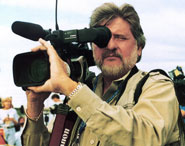|
|
Welcome to the November issue of The Digital Journalist, the monthly online magazine for visual journalism.
Twenty years ago this month the Berlin Wall fell. For those readers old enough to remember the Cold War, they don't need to be told that following World War II, and the partition of Berlin, the allies in the West and the Soviet Union in the East divided a city and a world. It was always the likely flashpoint for a third world war. When the Berlin Wall fell on Nov. 9, 1989, the Iron Curtain was lifted on Communist Eastern Europe. In short order, the Soviet Union was itself in the dustbin of history. Contributing photographer Peter Turnley witnessed all of the tide-turning revolutions in Eastern Europe, and was there when the Berlin Wall was literally torn apart. According to Turnley, "This period not only affected the geopolitical life of the world in a decisive way, but impacted the personal life history of anyone present, including my own." Among other major awards received that year, Turnley won the Olivier Rebbot Award from the Overseas Press Club for his coverage of the Eastern Bloc revolutions. Look at his photo gallery and you will see why. Included with his photographs and introduction is a video that he just did for CBS News Sunday Morning.
In our Dispatches this month, we have two very different stories about HIV/AIDS: Justin Mott covers the rejection of infected orphans from a local primary school in Vietnam and Ake Ericson journeys to Tanzania to cover HIV/AIDS vaccine trials that are starting to show some success. In our third dispatch by William B. Plowman, the photographer writes of the growing violence in Guatemala and the death of one TV journalist, Rolando Santis.
While everybody debates the current sad state of newspapers, the discussion only rarely considers the two separate and not equal halves that always made up the traditional "newspaper." Would the "first half" – the actual newsgathering and writing and editing – be in better shape today had newspaper management been more innovative and found some alternate delivery means that didn't involve the Industrial Revolution "back half" – the expensive and often inefficient production and delivery system? Gary Haynes, a veteran news photographer and editor, muses over that question in his guest column, "All the News That Fits the Horse-Drawn Cart."
Richard B. Stolley is one of the preeminent names in American journalism. Over his 56-year career as an editor at Time Inc., Stolley spent 19 years at the weekly Life, capturing the events and people of our time, and placing them in perspective for our history. He was also the founding editor of People, the most successful magazine in publishing history. Julien Russell Brunet interviewed Stolley about the changes he has seen in photojournalism, and his hopes for its future.
E-Bits Editor Beverly Spicer writes more this month about the crisis in the newspaper industry in "All Trees, No Forest." She suggests that although the large picture has not yet come into view during the forest fire that has consumed the industry, the winds may be beginning to shift, and there is hope. The infrastructure for a successful transition may already be in place.
Recently, Executive Editor Ron Steinman went to a garden party outside Philadelphia where he met many fine art photographers. Although the work they do and the methods they use are far different from the photojournalists we feature on The Digital Journalist, he learned they have the same problems of survival in this era of economic downturn.
Comcast, the largest cable provider in America, is hoping to buy NBC Universal, a move that is good for the business of TV but one that Ron Steinman believes will be bad for the consumer who once again will have little or no control over what is on the air and what it will cost. He explains why in his commentary, "Consumer Beware."
In her A Reporter's Life column, "Dream Come True," Eileen Douglas talks to a journalist who has hit the newsman's jackpot with a major best-seller to find out what life is like after lightening strikes.
David Burnett asks, "When the budgets that have been cut a dozen times already finally trim off the photography altogether, what in the hell do we do?" It is the question we have all been asking.
Karen Slattery and Mark Doremus discuss the bitter war going on between Fox News and the White House in their Ethics column.
Staff photographers are getting laid off. Freelancers are seeing less work. The Nikon D3x, the Canon 1DMk4 and Leica M9 are beginning to look a little pricey. Thus, this month's Nuts & Bolts column by Bill Pierce is about relatively cheap – oops, economical – stuff. Chuck Westfall is back with his usual helpful Q&As in Tech Tips, and Mark Loundy offers more "Common Cents."
Finally, in Camera Corner, guest contributor David Lykes Keenan reviews the new Leica M9, the world's smallest 35mm-equivalent full-frame camera. It is, he writes, "the camera many were hoping for three years ago when Leica delivered its first digital rangefinder." The Leica M9, he says, is "da bomb."
We think you will agree this is a provocative and important issue.
We hope you tell all your friends to visit. Dirck Halstead |

